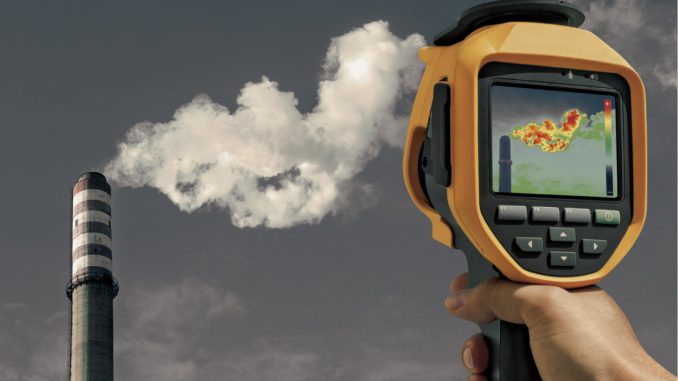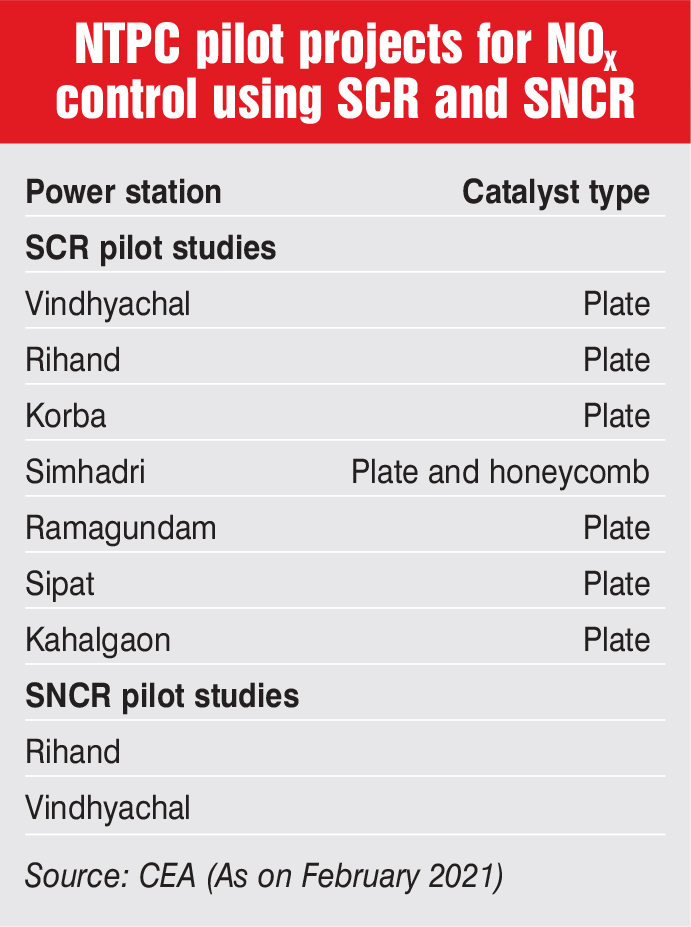
In thermal power plants (TPPs), the combustion of coal converts a large portion of the nitrogen bound in coal to form oxides of nitrogen (NOX) such as nitric oxide, nitrogen dioxide and nitrous oxide. The formation of NOX during coal combustion is influenced by combustion conditions and nitrogen content in coal. In December 2015, the Ministry of Environment, Forest and Climate Change (MoEFCC) notified the environmental standards, which specified the NOX emission levels for TPPs in the country. The NOX outflow limit for TPPs installed before December 31, 2003 was set at 600 mg per Nm3; for TPPs installed after January 1, 2004 and up to December 31, 2016, at 300 mg per Nm3; and for TPPs installed from January 2017 onwards at 100 mg per Nm3. Later, in October 2020, the MoEFCC relaxed the NOX emission norms for power plants commissioned between January 1, 2004 and December 31, 2016 from 300 mg per Nm3 to 450 mg per Nm3, following a request from power developers that it is not possible to meet the 300 mg per Nm3 standard at all loads. More recently, in April 2021, the MoEFCC extended the timelines for coal-based TPPs to comply with the emission norms by three to four years, depending on the location of the plant.
On the technology front, the NOX outflows can be brought down to 300-600 mg per Nm3 by utilising strategies such as combustion modification procedures. For additional reduction to 100-300 mg per Nm3 emission levels, advanced control procedures are required, which include selective catalytic reduction (SCR) and selective non-catalytic reduction (SNCR).
Primary NOX reduction technologies
The primary technologies include combustion measures that limit the production of NOX from the combustion zone by promoting its conversion to nitrogen. Over-fire-air (OFA) systems and low NOX burners (LNBs) are some of the technologies that are less expensive and can be executed rapidly versus advanced control procedures. Most TPPs commissioned after 2000 already have some form of in-combustion NOX control.
In LNBs, the initial fuel combustion occurs in the fuel-rich and oxygen-deficient zone. After this combustion, the air required to complete the combustion of coal is added. This reduces peak flame temperatures and slows down NOX formation. LNBs can help achieve a 30-50 per cent NOX reduction. In addition, they offer ease of installation and have a proven track record. LNBs have been in use for over 30 years in countries with similar emission control standards. LNB design has improved over the years and today’s ultra-low NOX boilers use advanced methods to reduce emissions. They are designed to control the mixing of air and fuel at each burner, creating more branched and larger flames. They also reduce the peak flame temperature, resulting in the formation of less NOX in the process. The improved flame structure simultaneously reduces the amount of oxygen available in the hottest part of the flame, thereby improving the burner’s efficiency.
An OFA system controls the oxygen availability near the burner area, thereby minimising the formation of fuel NOX. It diverts a portion of the combustion air away from the primary combustion zone. Of the required combustion air, 70-90 per cent is provided near burners, which creates an oxygen-deficient fuel-rich zone, leading to partial combustion of fuel. Subsequently, the balance combustion air is injected above the burner elevation through OFA nozzles into the furnace, where combustion is completed. The comparatively low temperature of the secondary stage restricts the production of NOX. Another benefit of the OFA system is that higher plant efficiency is achieved by reducing the amount of excess air in the system. The majority of existing boilers in India have stand-alone OFA systems, but they do not operate properly. If appropriately utilised, OFA technology can reduce NOX formation by 20-45 per cent. For optimum NOX reduction, LNBs and OFA systems should be used in combination.
Combustion optimisation is another method to control NOX emissions. Often when boilers are subject to frequent load changes and changes in coal quality, there are localised hotspots or temporary periods of incomplete combustion. This increases NOX emissions along with some other emissions and undesirable effects. To control this, combustion optimisation is important. In India, most boilers are tangentially fired and have lower NOX emissions than wall-fired boilers. Moreover, tangentially fired boilers have devices that can tilt the burner through an arc range of -30 to +30 degrees horizontally. Optimising the angle of this burner can also help in cotrolling NOX emissions. Thus, by controlling the boiler operating parameters (such as burner tilt, excess air and coal mill operations), NOX emissions can be significantly reduced.
NOX control at NTPC’s coal-fired plants is being achieved by adopting best combustion practices (primarily through excess air and combustion temperatures optimisation). To lower the NOX emission to optimum levels, NTPC has awarded combustion modification for over 20 GW capacity. As per the company’s annual report 2020-21, NTPC has completed combustion modification in 15 units of around 7 GW including units located in the NCR, namely two units of Dadri and three units of Jhajjar. Further, combustion modification for 34 units of around 14 GW has already been awarded.
 Post-combustion NOX control
Post-combustion NOX control
Post-combustion NOX control methods neutralise the NOX in the flue gas into nitrogen through chemical reactions. These technologies have a higher NOX reduction potential but their capital cost and operating costs are significantly higher. The two most widely used post-combustion NOX control technologies are SCR and SNCR.
In SCR technology, ammonia is used as a denitrification agent. A reagent such as aqueous ammonia, anhydrous ammonia or urea is injected into the exhaust stream, which is maintained at a specific temperature (depending on the catalyst used). The heat vaporises the ammonia. Nitrogen gas and NOX present in the flue gas stream react with vaporised ammonia in the presence of a catalyst (such as titanium oxide, vanadium, molybdenum and tungsten) and form nitrogen, water and trace amounts of carbon dioxide, which are expelled from the exhaust pipe. The reagent is optimised by maintaining a near-equal ratio with the NOX to be removed from the flue gas stream. It is suitable for NOX reduction of about 90 per cent. However, a disadvantage is that some unreacted ammonia might slip through the catalyst due to overinjection. Also, the catalysts used in the process are prone to contamination by compounds in the combustion gas.
SNCR is an alternative method for the reduction of NOX emissions. Under this, the injection of ammonia or urea into the flue gas is carried out without the use of a catalyst. The reagent is injected into specific temperature zones in the upper furnace or convective pass to reduce NOX to nitrogen and water.
Overall, SCR is more efficient in reducing emissions, but it is also significantly more expensive due to the need to purchase and maintain the catalyst. In India, a major problem with these systems is that the arrangement for availability, transportation, handling and storage of such large quantities of ammonia is yet to be addressed by TPPs. One of the issues in SNCR technology is the decrease in heat rate/boiler efficiency.
To meet the NOX emission limit of 100 mg per Nm3, NTPC is exploring the feasibility of SCR systems for units installed after 2017. SCR is a proven technology for low ash coal; However, it is yet to be proven for abrasive and high ash content Indian coal. In view of this, pilot tests have been conducted at seven NTPC stations by various SCR system suppliers to assess the suitability of SCR technology for Indian coal. These were undertaken at the Vindhyachal, Rihand, Korba, Simhadri, Ramagundam, Sipat and Kahalgaon TPPs. While the catalyst being used at the Simhadri TPP is the plate and honeycomb type, a plate-type catalyst is used at other TPPs. Further, pilot studies for SCNR technology are being undertaken at the Rihand and Vindhyachal TPPs. At these plants, four soot blowers were temporarily replaced with SNCR injection lances (two per boiler sidewall).
Conclusion
Indian power plants will need to install SCR/SNCR technology to meet the stringent NOX norms of 100 mg per Nm3. A major concern facing the industry is the technological limitation in implementing de-NOX systems. In addition, TPPs should prioritise controlling the emissions of harmful NOX. Simple steps could be taken to reduce emissions such as installing certain auxiliary equipment such as LNBs or OFA systems, and enhancing fuel quality. Furthermore, advanced NOX control such as installation of SCR or SNCR systems can be carried out following pilot studies if test results turn out favourable.



